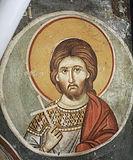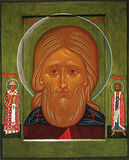

| Previous day | Next day |
| Old Style
April 7
|
Thursday |
New Style
April 20
|
| Bright Week. Fast-free period. | No fast.
|
![]() St. George the Confessor, bishop of Mytilene (820).
St. George the Confessor, bishop of Mytilene (820).
Martyr Calliopus, at Pompeiopolis in Cilicia (304). Hieromartyr Rufinus, deacon, and Martyrs Aquilina and 200 soldiers, at Sinope (ca. 310). St. Daniel of Pereyaslavl, founder of St. Daniel Monastery (1540). St. Serapion the Sindonite, monk, of Egypt (V). St. Nilus, founder of Sora Skete (Belozersk) (1508). Uncovering of the relics of St. Serapion, archbishop of Novgorod (1517). St. Gabriel, archbishop of Ryazan and Zaraisk (1862).
New Hieromartyr Arcadius Dobronravov, archpriest, of Tsivilsk (Chuvashia) (1933).
St. Hegesippus the Chronicler, of Palestine (ca. 180). Venerable Brynach of Wales (6th c.). St. George, patriarch of Jerusalem (807). St. Gerasimus, hieromonk, of Patmos (1739).
Repose of Schemamonk Theodore of Svir (1822) and Schemamonk Agapitus the Blind, of Valaam (1905).
Thoughts for Each Day of the Year
According to the Daily Church Readings from the Word of God
By St. Theophan the Recluse

Thursday. [Acts 2:38–43; John 3:1–15]
Beneficial is the work of those who, using sensible reason, crush the enormous lie mustered against the truth of the resurrection. Read and arm yourself with this reason; meanwhile, do not be too lazy to allow more and more space for the power of Christ’s Resurrection to enter into you. The more you do this, the more you will breathe the air of the Resurrection, and you will become quite safe from all the darts of the enemy, which are directed against this truth. You ask, what is needed for this? Nothing special: be the way you ought to be according to the vow you made in holy baptism, which is our resurrection. You spat on satan and all his works? So continue to preserve yourself thus in relation to him. Did you unite yourself with Christ? Then abide with Him. The deeds of darkness and light are obvious. Flee from the former and make all diligence with the latter. But do this without any compromises, even the smallest, so that the norm of your life becomes the following: there is no communion of light with darkness, or of Christ with Belial (cf. II Cor. 6:15).
Articles
 St. George the Confessor the Bishop of MytileneSaint George, Metropolitan of Mytilene, from his youth he led a monastic life, and was especially accomplished in the virtue of humility. |
 Venerable Daniel the Abbot of Pereslavl-ZalesskySaint Daniel of Pereslavl (in the world Demetrius) was born around 1460 in the city of Pereslavl-Zalessky. |
 Venerable Serapion of EgyptSaint Serapion lived during the fifth century in Egypt. He was called the linen cloth-wearer (Sindonite) since he wore only a coarse linen garb called a “sindon.” |




